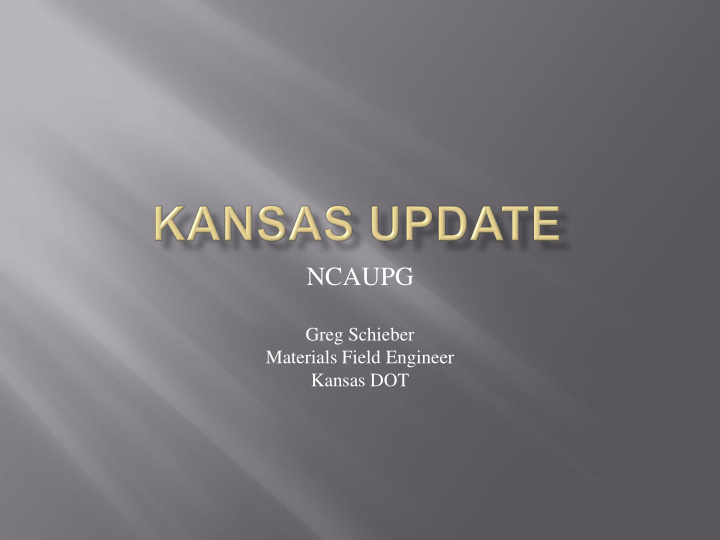



NCAUPG Greg Schieber Materials Field Engineer Kansas DOT
Advantages of using more RAP Economics Cost of Aggregates Cost of Asphalt Binder Transportation Costs Environmental Recycling Natural Resources It’s “Green”
Mixes With RAP 1,600,000 1,400,000 Tons of HMA with RAP 1,200,000 1,000,000 800,000 1-15 16-25 600,000 26-50 400,000 200,000 - Year
RAP < 25% Millings generated from project RAP < 15% Contractor provides millings FRAP Increase allowable RAP by 10% Fine FRAP passes ¼” screen Coarse FRAP retained on ¼” screen
Project Number %RAP HMA Tons Mix Type 083-097/055 KA-1040-01 35% 19,094 SR-12.5A 056-005 KA-1077-01 40% 9,717 SR-12.5A 056-005 KA-1077-01 30% 4,141 SR-12.5A 004/149-064/021 KA-1034-01 30% 44,218 SR-12.5A 004/104-085 KA-1037-01 25% 6,147 SR-12.5A 025-055 KA-1009-01 25% 56,177 SR-12.5A 083/036-020/090 KA-1039-01 25% 34,226 SR-12.5A 383-074 KA-1019-01 25% 17,987 SR-12.5A 281-092 KA-1017-01 25% 18,319 SR-12.5A 075-016 K -7415-01 25% 2,359 SR-19A 075-016 K -7415-01 25% 4,753 SR-19A Sh 400-008 KA-1057-01 25% 23,843 SR-12.5A Sh 050-028 KA-1082-01 25% 8,078 SR-12.5A 083-028/086 KA-1129-01 25% 38,100 SR-12.5B Sh
94 94 94 High Side of PG Grade High Side of PG Grade High Side of PG Grade 88 88 88 Rutting 82 82 82 76 76 76 70 70 70 PG 64-22 64 64 64 Cracking 58 58 58 -34 -34 -28 -28 -22 -22 -16 -16 -10 -10 -4 -4 2 2 -34 -28 -22 -16 -10 -4 2 Low Side of PG Grade Low Side of PG Grade Low Side of PG Grade
HMA TSRST HMA TSRST Project Number Binder RAP Not Aged Aged Not Aged Aged Project Number Binder RAP Not Aged Aged Not Aged Aged 025-055 KA-1009-01 62-28 76-14 72-33 72-25 -28 -28 025-055 KA-1009-01 62 -28 76 -14 72-33 72 -25 -28 -28 083-097/055 KA-1040-01 63-28 83-18 73-31 72-25 -28 -24 083-097/055 KA-1040-01 63 -28 83 -18 73-31 72 -25 -28 -24 056-005 KA-1077-01 63-25 83-12 78-26 78-18 -22 -22 056-005 KA-1077-01 63 -25 83 -12 78-26 78 -18 -22 -22 004/149-064/021 KA-1034-01 60-29 80-13 66-33 66-26 -28 -24 004/149-064/021 KA-1034-01 60 -29 80 -13 66-33 66 -26 -28 -24
6 of the 12 High RAP mixes had at least 1 Failed Modified Lottman Test
20 18 Avg Rut Depth (mm) 16 14 12 10 8 6 4 2 - 083-097 KA-1040-01 056-005 KA-1077-01 025-055 383-074 281-092 004-064 036-020 KA-1009 KA-1019 KA-1017 KA-1034 KA-1039 Failing Lottman Tests Passing Lottman Tests Borderline Lottman Tests
The 3 Projects with more than 25% RAP 1 received 14% of the available incentive 1 received 67% of the available incentive 1 received 100% of the available incentive Of the 9 Projects with 25% RAP 1 had a large disincentive 2 received less than 50% of the available incentive 3 received between 50% and 85% of the available incentive 3 received 100% of the available incentive
On 2 of the 3 High RAP Projects Low Voids in the Mineral Aggregate (VMA) resulted in production being suspended
Binder Quality and RAP Consistency are the biggest hurdles to overcome Blending Charts are reliable predictors of the resultant PG Grade (Virgin and RAP Binder) 40% RAP Mixes are achievable if • RAP properties are known • RAP is consistent (FRAP may be required) • Virgin Aggregates are selected to offset the shortcomings of the RAP Aggregates
Obtain millings for projects in early spring Send samples in to Materials Lab Burn-off on RAP and Fine and Coarse FRAP Determine the binder grade of the RAP Develop Blending Charts based on these results
Based on Blending Charts Contractor will determine the amount of RAP and FRAP to use Ensure that the low side of the binder is < -23 Still meet the volumetric requirements Provide the grading of the binder that we require During construction track the predicted value using the blending chart and RAP/FRAP properties. Penalty for a binder at > -23
Insufficient Bond Between layers Leading to premature cracking in overlays
Pave test sections with a Spray Paver Different Tacks Eastbound – EBL (Emulsion Bonding Liquid) Westbound – CSS-1H (Normal Tack Emulsion) Different Rates No Tack – up to 0.20 gal/sq yd
Goal: Have a pull-off test to ensure sufficient bonding HMA layers Specify a certain bond strength to be met Have a performance spec for the bond strength Starting this Spring visit multiple projects to start developing bond strength charts and relationships between type of surface and temperature Various surface Various temperatures
Test Method to determine the Tensile Rupture Strength for Polymer Bridge Overlays Modify the test method to determine the Tensile Rupture Strength between HMA layers
Compaction Aid Pave in cooler weather Green Benefits Reduced emissions Reduced fuel consumption Improvement in fatigue life of mix Less oxidized and less absorption
The Contractor is allowed to use Warm Mix unless otherwise shown on plans. Achieve Max density WMA > 165°F When mat temp falls below 165°F Roller Marks may be removed from mat with self- propelled static steel roller
Recommend
More recommend